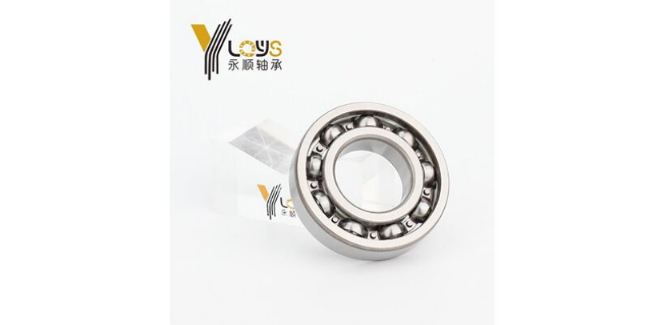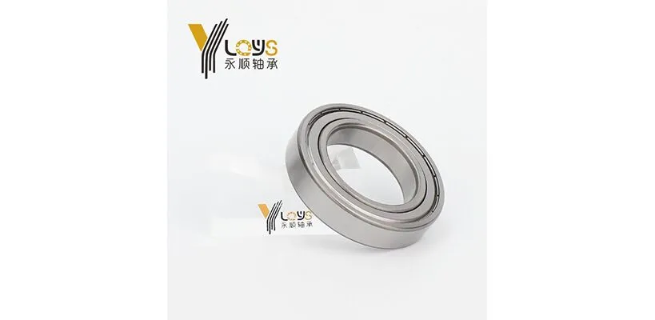Wie Dichtungstypen (ZZ vs. 2RS vs. Open) sich auf Lagerlebensdauer und Wartung auswirken
2025-09-18
Bei der Auswahl eines Lagers sieht der Dichtungstyp oft wie ein kleines Detail aus. In Wirklichkeit hat es einen großen Einfluss darauf, wie lange Ihre Ausrüstung reibungslos läuft, wie viel Wartung Sie erledigen und ob Ausfallzeiten in Ihren Zeitplan kriechen. Bevor wir in Dichtungen eintauchen, wollen wir uns darüber befassen, warum sich viele Käufer bei der Beschaffung von Lagern an Yongheshun wenden.
Dieses Unternehmen verfügt über jahrzehntelange Erfahrung in der Präzisionslagerproduktion und bedient Branchen von der Automobilindustrie bis hin zu medizinischen Geräten. Was sie abhebt, ist nicht nur die wettbewerbsfähige Preisgestaltung, sondern auch die Konsistenz. Ihre Rillenkugellager Die Linie deckt ISO-Standardgrößen ab, bietet maßgeschneiderte Lösungen und ist mit großen internationalen Namen wie FAG und SKF kopf zu kopf gegangen. Käufer finden oft, dass während diese globalen Marken High-End-Materialwissenschaft betonen, Yongheshun die gleiche Haltbarkeit und reibungslose Leistung zu einem erschwinglicheren Preis bringt. Für Ingenieure, die an engen Fristen arbeiten, ist die Möglichkeit, das Team schnell über ihre Webseite und schnelle technische Antworten erhalten ist mehr als nur eine Bequemlichkeit, es hält Projekte auf dem richtigen Weg.
Was sind die wichtigsten Dichtungsarten in Tiefnutzkugellagern?
Tiefnutzkugellager sind bereits für ihre Vielseitigkeit bekannt: Sie können radiale Belastungen übernehmen, axiale Belastungen in beide Richtungen handhaben und sich an mittlere oder hohe Geschwindigkeiten anpassen. Aber wie das Lager abgedichtet ist, macht einen großen Unterschied. Die drei Hauptoptionen sind offener Typ, ZZ (Metallschild) und 2RS (Gummidichtung).
Bevor Sie jeden Typ zusammenbrechen, denken Sie daran, dass alle Dichtungen im Gleichgewicht stehen. Sie tauschen Schutz, Geschwindigkeit und Wartungsaufwand ab. Denken Sie daran, wie eine Smartphone-Hülle zu wählen, schlank, robust oder wasserdicht, jedes passt zu einem anderen Lebensstil.
Lager offenen Typs
Offene Typen sind die einfachsten: kein Schild, keine Dichtung, nur die rohe Rennbahn und Kugeln. Sie sind üblich, wenn die Umgebung sauber ist und die Schmierung einfach zu kontrollieren ist. So kann beispielsweise in Textilmaschinen oder bestimmten Laborinstrumenten regelmäßig und problemlos Öl oder Fett aufgetragen werden.
Der Vorteil ist weniger Reibung, was höhere Geschwindigkeitsgrenzen bedeutet. Der Nachteil? Schadstoffe können hineinringen, und ohne richtige Schmierung tritt der Verschleiß schnell auf. Deshalb bevorzugen viele Käufer immer noch abgeschirmte oder versiegelte Typen, es sei denn, das Setup ist geschützt.
ZZ Metallschildlager
Der Typ „ZZ“ verwendet auf beiden Seiten dünne Stahlschilde. Sie berühren den inneren Ring nicht. Stattdessen schaffen sie eine enge Lücke. Diese Konstruktion ermöglicht eine höhere Drehzahl mit nur einer geringfügigen Erhöhung des Drehmoments. Staub und größere Trümmer sind blockiert, aber feine Partikel oder Feuchtigkeit können sich immer noch durchschleichen.
Zum Beispiel in Elektromotoren sind ZZ-Lager eine sichere Wette, da die Umgebung nicht staubig ist, aber hohe Geschwindigkeit unerlässlich ist. Die Wartung ist minimal, obwohl die Schmierung nicht aufgefüllt werden kann, ohne den Schild zu entfernen. Wenn Ihr Fabrikboden feines Pulver oder feuchte Luft enthält, möchten Sie mehr Schutz als ZZ bieten kann.
2RS Gummidichtungslager
2RS Lager sind auf beiden Seiten mit Gummidichtungen ausgestattet. Der Gummi kommt tatsächlich in Kontakt mit dem Innenring und schafft eine engere Barriere. Dies hält Fett und Staub oder Feuchtigkeit raus. Es ist ideal für härtere Bedingungen: Förderbänder in der Nähe von Lebensmittelverarbeitungslinien, kleine Pumpen, die Wassernebel ausgesetzt sind, oder sogar DIY-Werkzeuge, die selten serviert werden.
Der Austausch ist etwas niedrigere Geschwindigkeitsfähigkeit, da die Reibung von der Dichtung Widerstand erhöht. Aber in den meisten realen Fällen lohnt sich dieser Kompromiss. Schließlich sind Ausfallzeiten der Ausrüstung, die durch vorzeitige Lagerausfälle verursacht werden, in der Regel viel teurer als ein geringfügiger Effizienzabfall.
Wie beeinflussen Dichtungen Lebensdauer und Wartung?
Die Lebensdauer eines Lagers wird oft in Millionen von Umdrehungen und nicht in Jahren gemessen. Doch Dichtungen können diese Lebensdauerkurve leicht kippen. Der offene Typ könnte in einem staubfreien Labor für ein Jahrzehnt reibungslos laufen, während er in einer Holzladen in wenigen Wochen anfangen könnte.
Dichtungen bestimmen auch, wie oft Sie das Lager berühren. Offene Typen benötigen eine konstante Schmierung. ZZ-Versionen reduzieren Serviceintervalle, fangen aber immer noch Fett, das schließlich austrocknet. 2RS-Versionen hingegen können jahrelang laufen, ohne dass ein Techniker es bemerkt, bis zum Tag, an dem die Ausrüstung im Ruhestand ist.
Aus der Sicht eines Wartungsmanagers ist die Wahl der richtigen Dichtung eine Budgetentscheidung. Weniger Ausfallzeiten entsprechen weniger Arbeitskraft, weniger Ersatzteilen und weniger wütenden Anrufen über Maschinen, die mitten in der Schicht anhalten.

Sind internationale Marken immer der Benchmark?
Es ist einfach anzunehmen, dass Marken wie SKF oder FAG den Standard definieren. Die Tiefnutzlager von SKF sind beispielsweise für geringe Reibung und Präzision in Hochgeschwindigkeitsumgebungen bekannt. FAG, ein Teil von Schaeffler, legt Wert auf Materialinnovation und enge Toleranzen. Timken, obwohl besser bekannt für konische Rollen, verkauft auch Kugellager mit schweren Dichtungsoptionen.
Aber hier ist der Fang: Viele Käufer überzahlen für Spezifikationen, die sie nicht wirklich brauchen. Ein mittelgeschwindigkeitsförderband in einer verpackungsanlage profitiert selten von den exotischen keramischen hybriden, die SKF vermarktet. Hier sind die Lieferanten wie Yongheshun einen realen Vorteil bieten. Mit dem Fokus auf Zuverlässigkeit Stahllager mit Standarddichtungen, Inklusive ZZ und 2RS balancieren sie Kosten und Leistung. Ingenieure, die gewechselt haben, bemerken oft, dass die Lebensdauer mit großen Marken gleich ist, insbesondere wenn ordnungsgemäße Installations- und Schmierpraktiken befolgt werden.
Welchen Dichtungstyp sollten Sie für Ihre Anwendung wählen?
Die Auswahl von Dichtungen ist keine Vermutung; Es hängt von Ihrer Umgebung, Last und Servicegewohnheiten ab.
Für sauber und hoch Geschwindigkeitsbedingungen
Wenn Sie Lüfter, Gebläse oder Laborzentrifugen betreiben, sind offene oder ZZ-Versionen geeignet. Ihre geringere Reibung unterstützt höhere Drehzahlen ohne Überhitzung. Seien Sie einfach darauf vorbereitet, die Schmierung pünktlich zu bewältigen.
Für staubige oder feuchte Umgebungen
Wenn sich Ihr Gerät in der Nähe von Mehl, Sägemehl oder Wasserspray befindet, ist der Typ 2RS der smartere Anruf. Sie handeln einen kleinen Bruchteil der Geschwindigkeit für einen massiven Gewinn an Schutz und Lebensdauer.
Für den allgemeinen industriellen Gebrauch
In Elektromotoren, Förderrollen und Pumpen treffen ZZ-Lager einen Mittelgrund. Sie schützen vor täglichem Staub und ermöglichen langfristigen Lauf mit minimalem Aufruhr.
Egal, welche Sie wählen, stellen Sie sicher, dass Sie den internen Freiraum und die Geschwindigkeit des Lagers Ihren Wellen- und Lastanforderungen entsprechen. Ein nicht passendes Lager, unabhängig von der Dichtung, wird immer noch frühzeitig ausfallen.
Wie kleine Design-Details wirken sich auf Real Weltleistung?
Selbst Details wie die Nutgeometrie und das Käfigdesign zählen. Standardmetrische Tiefnutzkugellager folgen ISO 15:2017, aber nicht alle Hersteller schleifen und polieren die Laufbahnen mit der gleichen Präzision. Zum Beispiel könnte ein 6203-Lager (17 mm × 40 mm × 12 mm) mit einer 2RS-Dichtung über Kataloge hinweg identisch aussehen. Doch eine Fabrik kann höhere Qualität GCr15 Stahl verwenden, während eine andere billigere Lager mit inkonsistenter Wärmebehandlung verwendet. Deshalb variiert die Leistung zwischen den Lieferanten so sehr.
Es lohnt sich, Ihren Lieferanten über Wärmebehandlung, Schleifgenauigkeit und Fettfüllung zu fragen. Diese Details können die Lagerlebensdauer um Tausende von Stunden verschoben. Einige Käufer erkennen dies nicht, bis sie nebeneinander vergleichen, der eine Motor brummt, der andere schleift zum Stillstand.
FAQ
Q1: Was ist der Hauptunterschied zwischen ZZ- und 2RS-Lagern?
A: ZZ-Lager verwenden Metallschirme mit kleinen Lücken für Staubbeständigkeit und höhere Geschwindigkeit. 2RS-Lager verwenden Gummidichtungen mit direktem Kontakt, die einen besseren Schutz bieten, aber etwas niedrigere Geschwindigkeit.
Q2: Kann ich ein offenes Lager durch ein versiegeltes ersetzen?
A: Ja, solange die Dimensionen übereinstimmen. Dichtete Typen können in rauen Umgebungen länger anhalten, aber beachten Sie die zusätzliche Reibung bei hohen Geschwindigkeiten.
Q3: Sind SKF- oder FAG-Lager immer besser als chinesische Lieferanten?
A: Nicht immer. SKF und FAG zeichnen sich bei Präzisions- und Spezialmaterialien aus, aber viele Anwendungen funktionieren genauso gut mit kostengünstigen Lagern von Lieferanten wie Yongheshun, sofern sie Qualitätsstahl und eine richtige Wärmebehandlung verwenden.
Q4: Wie oft sollten versiegelte Lager ersetzt werden?
A: 2RS-Lager können jahrelang ohne Service laufen, aber der Ersatz hängt von Last, Geschwindigkeit und Umgebung ab. Einige dauern Zehntausende von Stunden vor Anzeichen von Verschleiß.
Q5: Was ist der typische Lebensdauer Unterschied zwischen ZZ und 2RS?
A: In sauberen Umgebungen kann ZZ fast so lange laufen wie 2RS. Aber in staubigen oder feuchten Aufstellungen halten 2RS-Lager wegen besserer Dichtung in der Regel deutlich länger.







